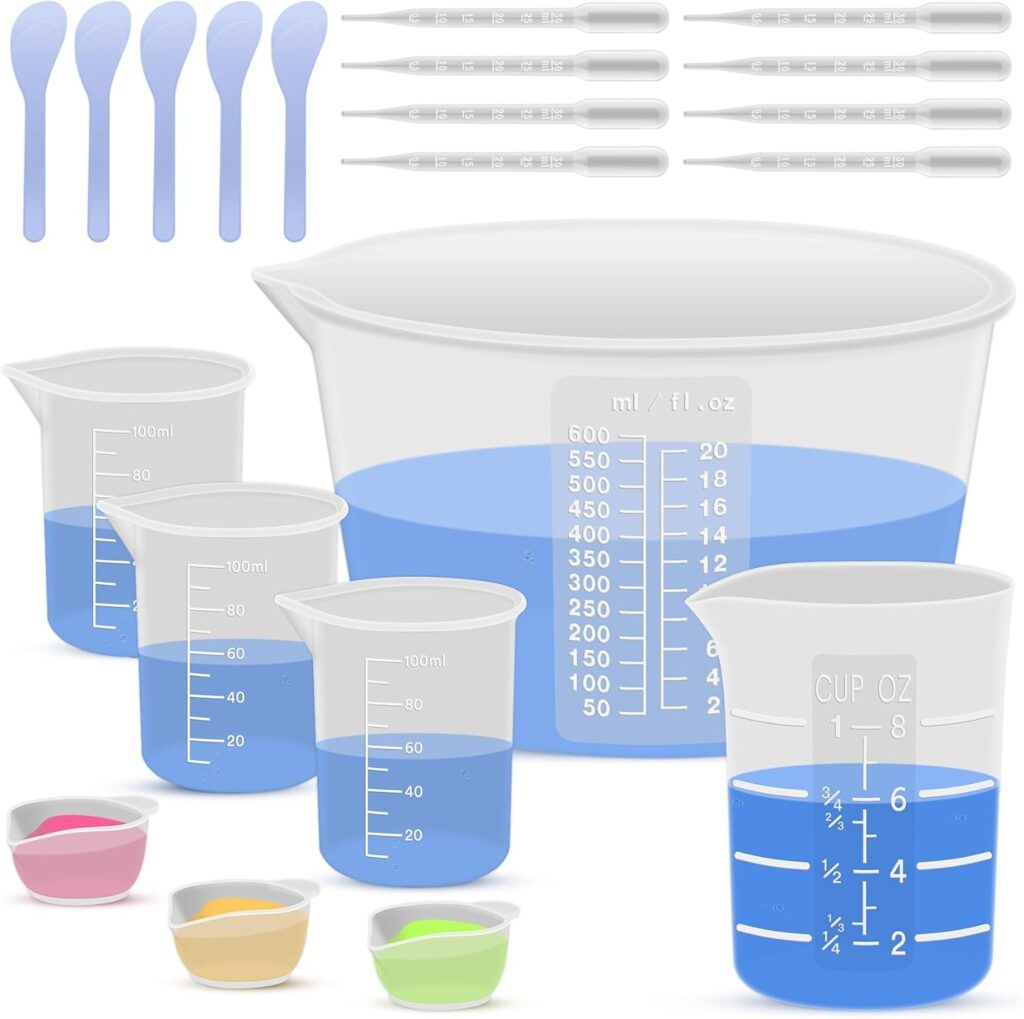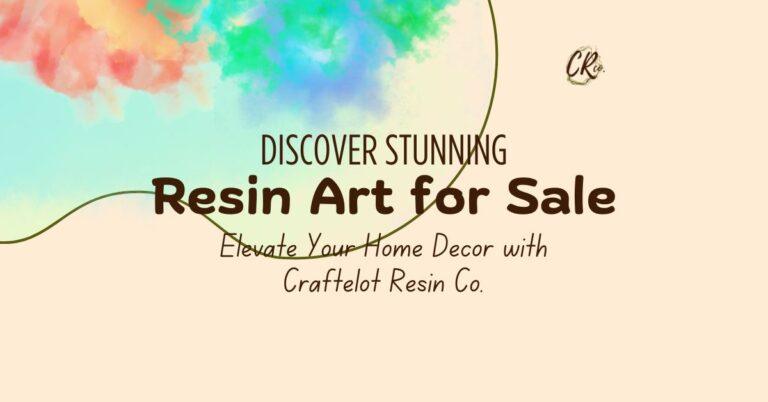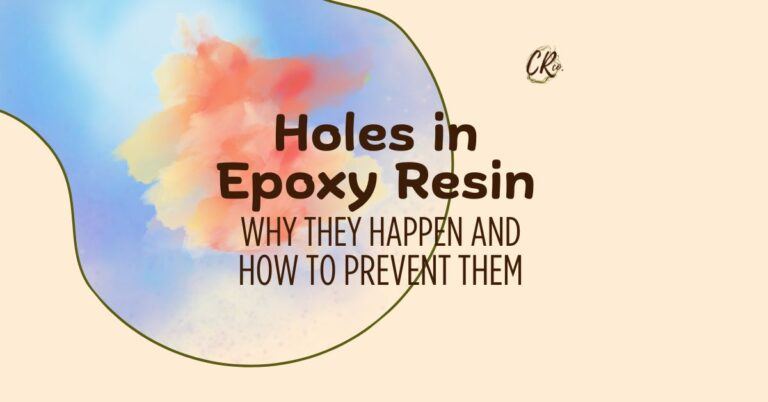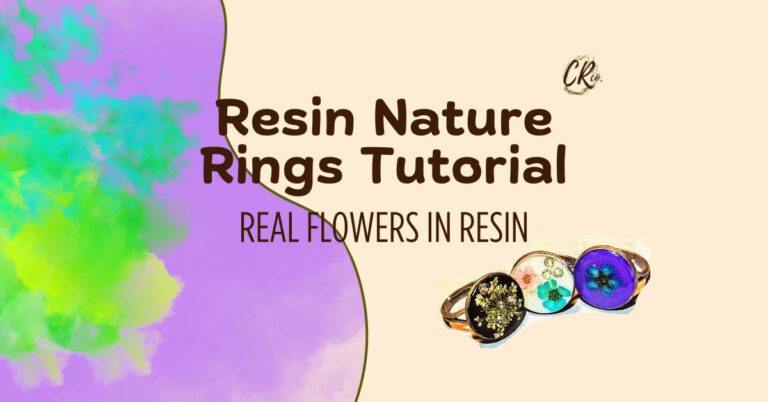Geode Resin Coasters Tutorial
Follow along with us and learn how to make your own gorgeous resin geode coasters! Here, we have included a video and written tutorial to show you the exact steps to follow to create a beautiful coaster set of your very own. We have also included a list of the products you will need to create the look we achieved in our coasters. Hope you enjoy and we would love to hear your feedback in the comments section below.
In this video, I use multiple mediums, including pigment powders, alcohol inks, acrylic paints, and pigment pastes, to color the epoxy resin. Using multiple mediums creates different effects. The differing weights of the mediums forces some of the colors to sink, while other rise to the surface, and others disperse into other areas of the mold. Here is a list of all of the mediums I used, with links to buy the exact brands I used if you are attempting to recreate the effects in these coasters.
What you will need for Resin Geode Coasters
The following materials will be needed to make these beautiful brown, black, and gold resin geode coasters. The mold I use is really affordable and can be purchased on Amazon by following the link below. I get a lot of compliments of these resin geodes and I encourage you to experiment with different colors when using this technique. If you use to same types of color mediums, no matter the color theme, you are bound to create something special. If you want to create a different type of coaster set, here is a link to my top picks for coaster molds for resin! If you are attempting a different resin art project, remember to check our epoxy resin recommendations in Best Epoxy Resin For Art Projects–Everything You Need To Know.
Here are the resin geode coaster materials used in this video:
Resin Geode Coaster Materials
-
Dark Brown Alcohol Ink
Brownish Black Pigment Paste-
Gold Pigment Powder
Castin’ Craft White Pigment
NicPro Epoxy Resin
Geode Silicone Coaster Mold
Geode Resin Coasters Video Tutorial
Geode Resin Coasters Written Tutorial
Step One: Prepare Workspace and Wipe Down Silicone Mold
First, you want to prepare your workspace. Doing this properly will lead to far less headaches both during the resin pouring process as well as during the cleanup process. My best advice for this step is to get silicone happy! I am so obsessed with resin crafting that, when I see a kitchen tool in silicone, I am buying it. Even if I don’t have a particular use for it quite yet, I know that I will eventually find a way to use it with my resin artwork. The reason silicone is so important for resin artists is that silicone and resin do not stick to each other. Silicone is the easiest surface to clean up after resin has cured because the cured resin just peels away from the silicone. Hence why we use silicone molds. I recommend you buy yourself a kits like the one below, which includes silicone measuring cups, silicone stir sticks, and even gloves. These are cheap and great to have around for resin art because you can use them again and again!
I can not stress how important it is to make sure the surface you are working on is level! Use a level tool to check that your canvas sits flat on your workspace. This will prevent you from losing any designs you made in your resin and ensure your coasters do not turn out lopsided.
Many people skip this next portion of the process, but it can make all the difference in how your final resin geode coasters turn out. If there is any resin left over from previous projects or dust in the mold from storage, you want to wipe your mold down with some isopropyl alcohol and a paper towel. Paper towels work well because they do not leave any residue after wiping. The isopropyl alcohol will ensure the cleanest surface for pouring your resin.
As far as work surfaces go, make sure yours is covered with a silicone crafting mat. Check out Best Silicone Craft Mats for our top recommendations.
Step Two: Choose your Pigments
Pick out the pigment (colors) you want to use for your project. I have listed the colors I used in the material list above if you want to attempt to get the same type of colored effect I got in my resin geode coasters. On your silicone craft mat, within reaching distance of your molds, lay out a row of silicone or plastic cups. Paper will work, but it is hard to reuse them. Silicone and plastic materials will always be the most cost efficient and environmentally friendly(because we can recycle them over and over) materials to use for resin crafting.
Put a dime-size amount of each pigments into each cup.
Note: Remember to put your pigments into your cups before mixing your epoxy! This gives you more time after mixing your epoxy, which is valuable as a beginner. Before you get used to only having a limited amount of time to work before your epoxy starts to harden, little tips like these make all the difference and will prevent major frustration, as well as waste. Committing to your color choices before hand also protects against indecisiveness, leading you to commit to your colors before you even think about mixing up that epoxy and starting the clock!
Step Three: Mix Epoxy Resin
Measure and Mix According to Directions on the Bottle
Check out How to Mix Bubble-Free Epoxy Resin for great tips.
No matter the brand of epoxy resin you choose, you must follow the directions on the bottle. Most epoxy resins require a 1:1 ratio of epoxy resin and hardener. However, there are a few brands where this differs. Be aware of whether the directions call for a 1:1 ratio measured by weight or a 1:1 ratio measured by volume. Usually, mixing instructions call for measuring epoxy resin by volume. If this is the case, all you need is a plastic or silicone measuring cup.
Use Silicone or Plastic Products with Epoxy Resin
I suggest you buy a cheap silicone measuring cup, like this one listed on Amazon:

(It even comes with silicone stir sticks, which you will use, and little finger condoms, which you probably will not, but who does not love a freebie?)
Mix Thoroughly/ Avoid a Sticky Mess
When mixing, be sure to mix thoroughly. You will know the product is mixed when you stop seeing strings of resin in the cup. Also, be sure to scrape the sides and bottom of the cup to ensure thorough mixing. If you do not do this, you may end up with sticky parts on your project.
Mix Slowly/ Avoid Bubbles
Another great tip is to mix slowly.
Mixing slow helps prevent air bubbles in your epoxy resin.
Wooden Stir Sticks=More Bubbles
If you have issues with air bubbles, you may also want to switch up your stir stick. A wooden stir stick, being porous, may also introduce extra air bubbles into the epoxy resin while mixing. Using a silicone stir stick will prevent this problem.
Step Four: Mix Pigments and Epoxy Resin
Mix epoxy resin into your cups with the pigment powder. Thoroughly mix your pigment powders with epoxy resin. Once you color your epoxy with pigment, move on to the next step.
NOTE: Leave a large amount of clear resin in your original cup. Most of each mold is to be filled with clear resin to achieve the stone-like effects shown in the video.
Step Five: Pour Your Resin Geode Coasters
First, Let’s Learn some Resin Art Chemistry
My number one tip for getting effects in resin coasters is to use multiple types of mediums. Working with resin, an artist learns to take advantage of reactions (resulting in interesting details) created when mixing different pigments. Some examples of pigments are paints, inks, powders, glitter, etc.
Even the world’s leading pigment mixing chemist could surprise herself when she sees the final piece.
It seems logical that the reactions between pigments are a result of differing densities. The different densities mean each type of pigment differs in weight. A seasoned resin artist can somewhat predict the types of effects that will result in a final product, based on which pigments she employs. For example, resin colored white with acrylic paint (thick and heavy) poured with resin colored red, with a liquid (thin and light) alcohol ink, will produce a product where the red-pigmented resin has floated to the top. Sometimes the resin mixed with the heavier pigment will dictate the color of the rings that form around any cell structures. So in this scenario, the white-pigmented resin displays as rings or outlines of the cell structures in your piece. The red-pigmented resin forms the actual cells or insides of the white circles. This effect is exasperated if you use a cell activator like silicone oil or ResiBlast.
Okay, enough of that. How did we come up with the effects we did in our resin geode coasters? Here is the order we poured our pigments, for those of you trying to get the same effects we did.
How to Emulate the Effects In our Resin Geode Coasters
- Pour resin colored with dark brown alcohol ink around the edge of half of your coasters.
- Pour the resin colored with brownish-black pigment paste around the corner of the other half of your silicone molds.
- Pour pigment paste colored resin into the molds you poured your alcohol ink colored resin into and vice versa.
- Be careful to stay on the edges of each mold.
- Next, pour a ring of the resin colored with white Castin’Craft into each of the geode coaster molds.
- Then, add a ring of the resin colored with Gold Pigment Powder to each of the coasters.
- Again, try to keep the center of each coaster mold clear of resin if possible.
- From about 6 inches above the coaster molds, pour clear resin into each of the coaster molds, filling up to the rim.
- If you have any remaining colored resin, pour quick circles into the resin molds.
- Use a heat gun to pop any bubbles that have risen to the surface.
TIP: Remember not to hold heat in one spot for too long as it may burn the resin and ruin your pieces.
- Finally, add embellishments of your choice into the center of each coaster mold.
- Use a touch lighter or heat gun to pop any bubbles that formed from adding the embellishments.
- Let cure for 24 hours before demolding.
Step Six: Let Resin Cure
Let your coasters cure overnight and demold. If you would like, take a metallic paint pen and trace along the edges of your coasters to add a bit more flare.
Stay Gorgeous, Stay Creative!
I hope you guys enjoyed this video and post.
If you follow the directions in this article and watch the video tutorial, I have no doubt you will create something beautiful.
Hope to hear from you in the comments below. Feel free to share your work on our Facebook page!
xoCraftelot





Thank you for sharing how to make these coasters. You have beautiful items in your store. Do you make everything that you sell? I wanted to make candles and have a store online, I may do this one day. Your work is beautiful!
Stephanie- I am so glad you enjoyted the geode coaster tutorial! I do make every item in my store. 🙂
Hello,
Wow! I watched the video and learned something new today. I assume these coasters are for cups or other decorations? I only heard about the term geode from the movie The Core, wherein they found a hollow space in the mantle of the earth. With, epoxy resin, the first time I see an application of this is for guitar bodies made out of this or holes or molds on the guitar body then pour inks and epoxy resin for effects. I love how you presented it in a video format so we can easily understand more about how to tackle this kind of art/project.
Geodes are sometimes called rock crystals or druzes. You may be more familiar with those terms.
I have never seen The Core. I will have to check it out.
I too have seen the guitars made from epoxy resin. They look beautiful, but I feel they would be uncomfortably heavy if made from epoxy. They definitely get the WOW factor tho.
I am glad you enjoyed the video. Thanks for stopping by!